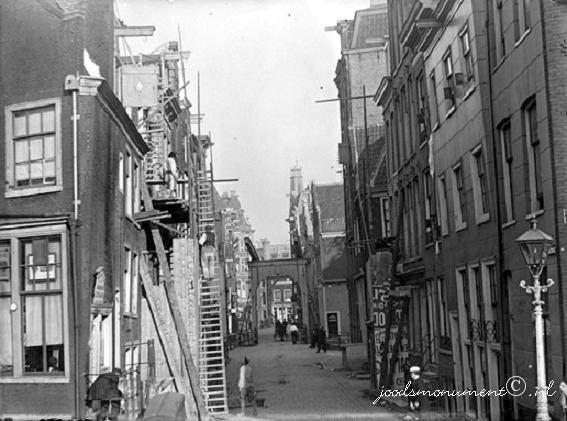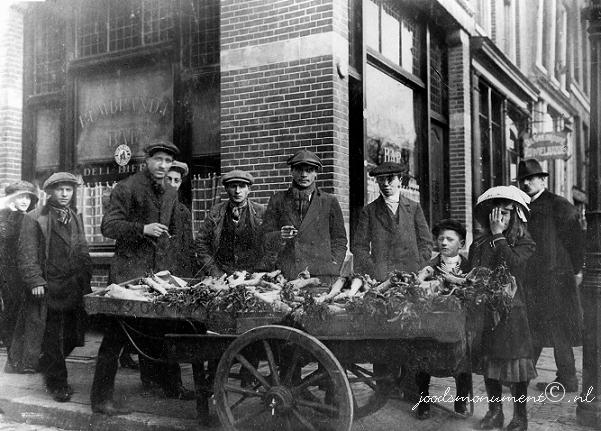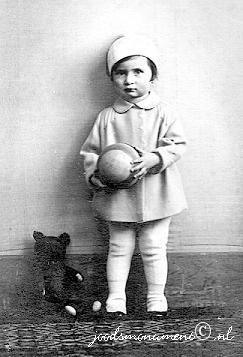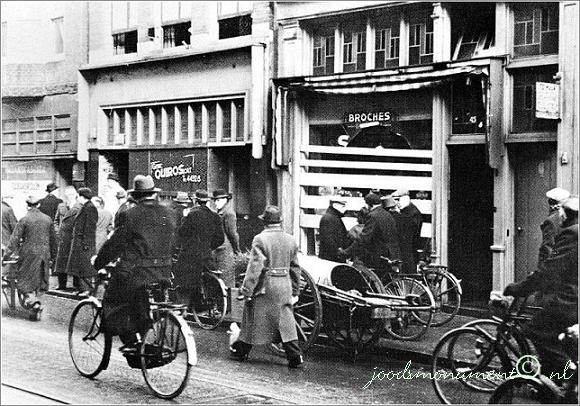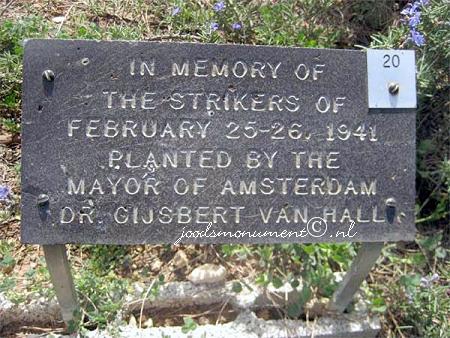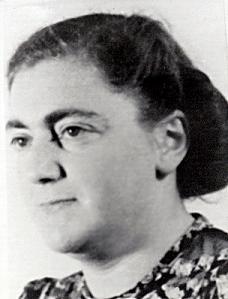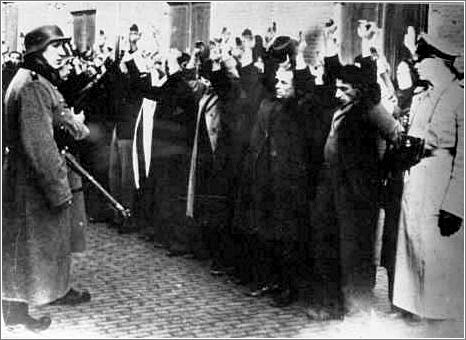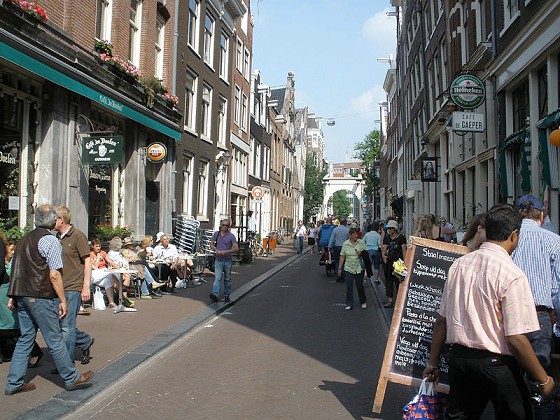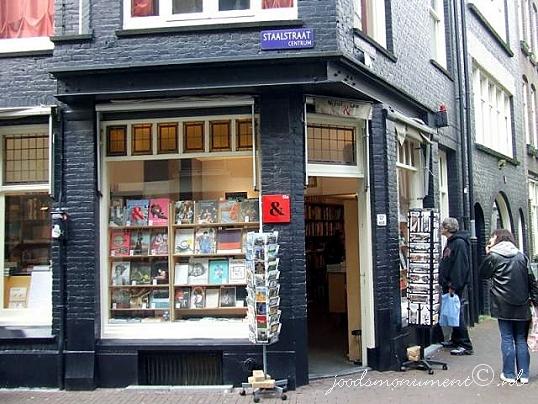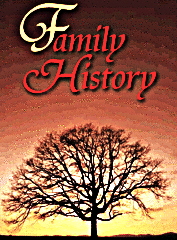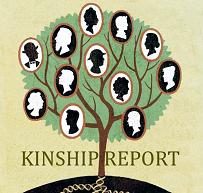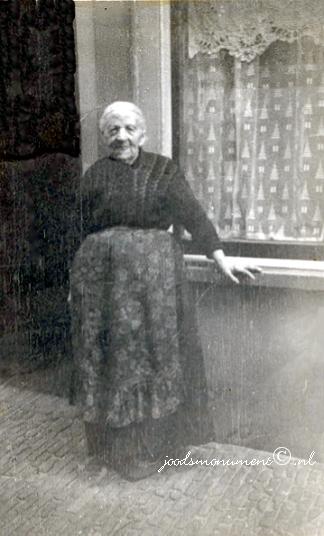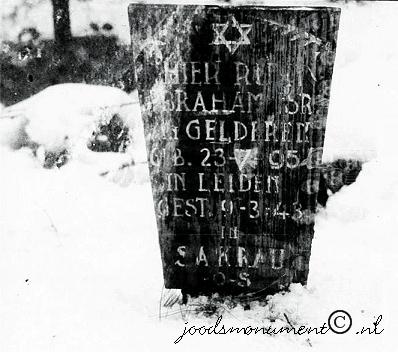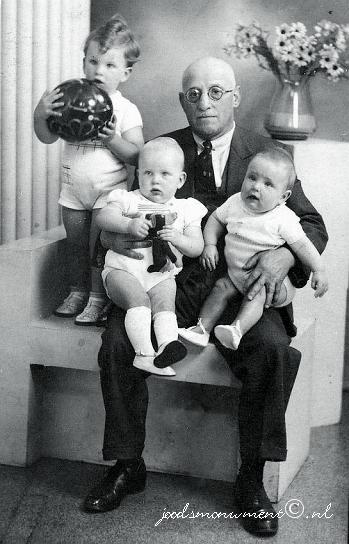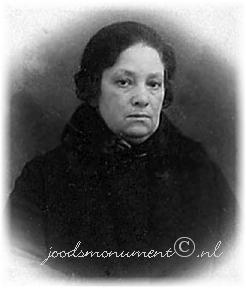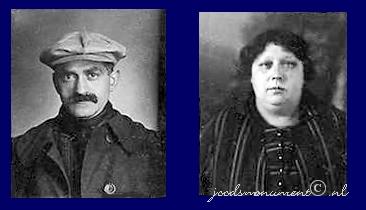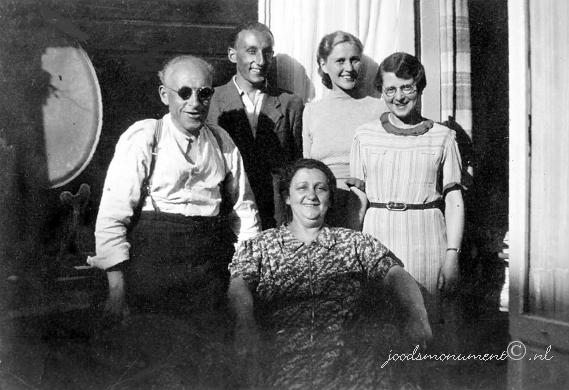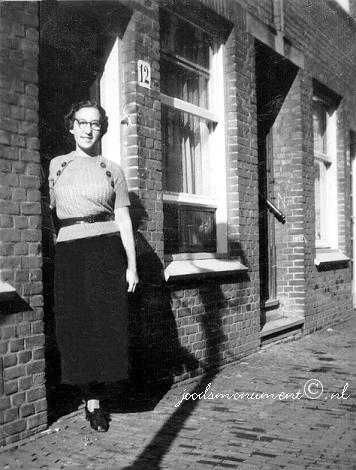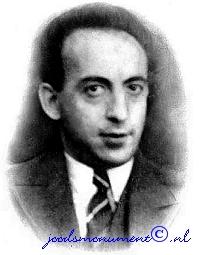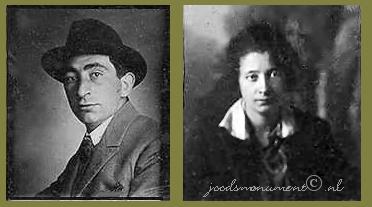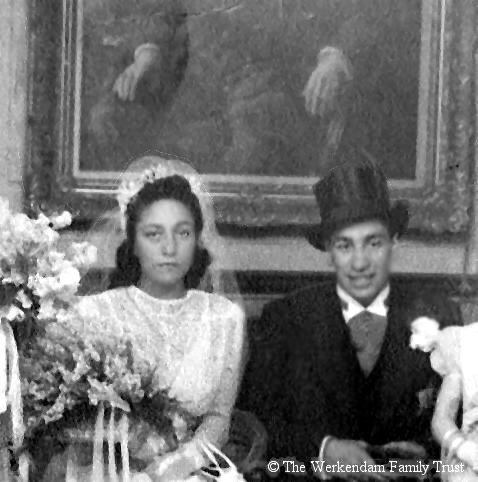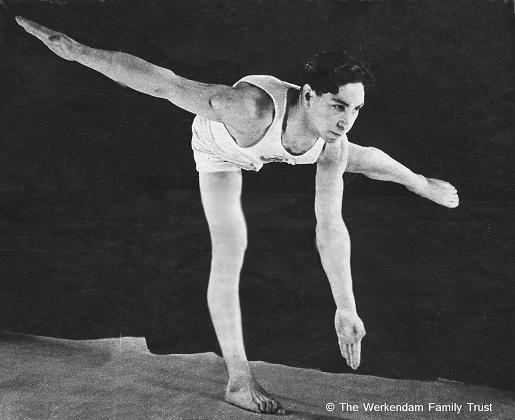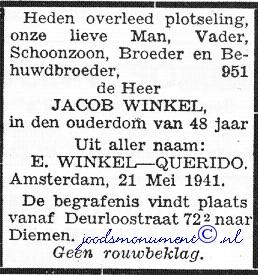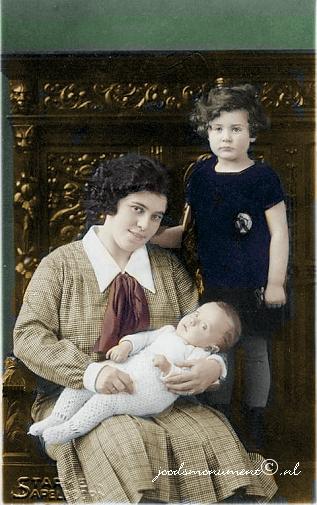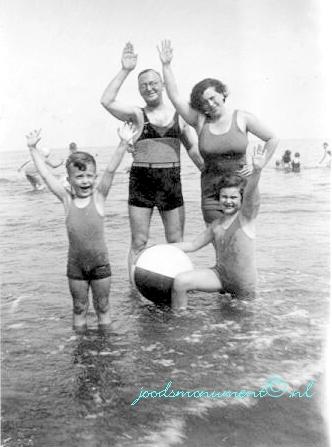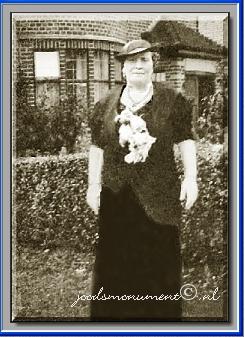|
Tragically hundreds of Sasieni/Sassienie Dutch relatives did not survive the war and are too many for all to be represented on the Sassienie Worldwide Family Website. The following 10 pages are only a minority of our Dutch family branches that did not succeed the Final Solution or Final Solution to the Jewish Question, Nazi Germany's plan during World War 2 to systematically eliminate the entire Jewish populations in Nazi-occupied Europe through genocide that became known as the Holocaust. WARNING
PLEASE READ THIS MESSAGE BEFORE VIEWING THE, Dutch Family, A Turbulent Family History pages.
Sadly our Dutch relatives have become synonymous with the Holocaust and this is a part of our family history.
There are no disturbing images or extreme reports on these pages, except that these people are our relatives. Some featured individuals and families are wearing the yellow stars imposed on the Jewish populations in occupied Europe by the Nazis during that era. The publications also include dates and places with some brief details mostly toned down for the benefit of child readers who may take a keen interest in their family history.
But some may find the photos, details and articles disturbing and distressing; therefore it is advised that viewers who wish to read these pages, do so at their own discretion.
Dutch Family, A Turbulent History
Ranging from closely family connected, 5th cousins to 12th cousins of all Sasieni/Sassienie family members
This section is dedicated to our Dutch family members, most whom had perished during the Holocaust, in order that their sufferings, achievements and history will be remembered by our present day family members, made known to the younger generations and our future generations.
Literally whole family branches were wiped out, leaving at present times only distant cousins as their closest living relatives, including the Sasieni/Sassienie branch.
The very few that survived the German Nazi occupation of countries in Northern Europe during World War 2 strived on to continue their family line and somehow managed to prosper, either in their countries of origin or by seeking new lives abroad.
All individuals listed in the Dutch Family, a Turbulent History section are related or family connected to all Sasieni/Sassienie family members.
All images are copyrighted and the property of the contributors
A Traumatic End The Long Forgotten Sassienie Dutch Relatives
These are the significant details, facts and stories about some of the cataclysmic tragedies of the Holocaust regarding the Sassienie family’s closest Dutch relatives. The destruction of so many families. Grandparents, parents, brothers, sisters, uncles, aunts and cousins. Their homes and assets plundered, their lives torn apart and then murdered simply because they were labelled as Jews.
The story of Emanuel Staal, his son Jacob Staal and the Staalstraat, a part of the Jewish quarter of old Amsterdam in Holland This is an account of how a Dutch Jewish family in Amsterdam grew from poverty during the nineteenth century to running a series of lucrative businesses, their devastation during the German occupation of Holland, their post war homes turned into brothels and a sequence of events leading up to the present day. The article gives us an insight into the lives of our Dutch family members and the Jewish quarter of Amsterdam, before, during and after the second world war. A captivation of their lifestyles, hopes, dreams and continued determination to progress, including the events that lead to their impending deportation.
It reveals that there was much more to those who were murdered other than just names, dates and statistics, but were extraordinary people with lives and families who had ambitions and hopes, which provides us with a better understanding of the details that follow in the: Dutch Family, a Turbulent History.
Emanuel Staal b. December 19, 1852 Amsterdam, Holland – d. January 22, 1943 Westerbork transit camp, Holland
Emanuel Levi Staal, son of Levi Moses Staal and Branca Agtienribbe Moses, was born on 19 December 1852 and grew up in the Uilenburgerstraat, the heart of Amsterdam's old Jewish quarter. Nothing is known about his youth and when in 1879 he married Lea Wijl, there was no mention of his occupation. Ten years later during his second marriage to Mietje Andries Groenewoudt, he is listed as a diamond worker.
Emanuel and Lea married on June 4, 1879 in Amsterdam, Holland and the service takes place at their residential address, Verversstraat 13. There are five children: Levi, born in 1880 and died about 1949 in the United Kingdom, Sientje (1882-1883), David (1883-1942 Auschwitz), Branca (1885-1942 Auschwitz) and Jacob (1887-1942 Auschwitz). Tragically on May 11, 1889 at the age of 42 Lea dies and Emanuel is left to care for four young children. Only two months later, Emanuel marries Mietje Andries Groenewoudt in Helmond Holland, born in 1862 in Aarle-Rixtel, daughter of Andries Samuel Levie Groenewoudt and Sara Hartog Andriessen. She already has a son, Andries Groenewoudt (1886-1942 Auschwitz), who is included into the Staal family. Later there are two other children born: Sarah (1891-1942 Auschwitz) and Geertruida (1893). The family Staal-Groenewoudt lived for many years at various different addresses in Amsterdam, Holland: St.Antoniesbreestraat, Jodenbreestraat, Jacob in Campenstraat and from 1894 at the Staalstraat 17 hs. Besides diamond cutting Emanuel Staal was also a bookseller from 1886. Prior to 1886 there are no records of Emanuel’s occupations. It is likely that during those years Emanuel had a stall in the Nieuwmarkt at Waterloo-plein and later as his business became more lucrative progressed to acquiring a small second-hand and discount bookshop in the Staalstraat. Sijthoff is a combination of the publishing houses Sijthoff established in 1851 and Luitingh, set up in 1947. The Sijthoff Address Book for Netherlands Books and related subjects mentioned Emanuel Staal as a bookseller between 1904 and 1908 and from 1905 to 1940 as a reading library keeper, then from 1938 to the address Staalstraat 13a. The bookstore appears after 1908 and gradually moved to the leesbibli-O-library.
Staalstraat 1900
Siegfried van Praag gives Sam Levita's Life in Dance (Allert de Lange, Amsterdam, 1927) a characteristic description of the Staalstraat at the beginning of the twentieth century: Travel down the street, view the neglected buildings with the worn slates and in disrepair, then you will find their homes. These homes mostly consisted of basements with two rooms. The fronts are where they lived, ate and worked, with whole family’s sleeping in a back room. A father, a mother and two sons, Joseph and Sam. The cellar accommodations were located in Staalstraat, an eyesore that cluttered the more picturesque surroundings of old Amsterdam. Nearby, almost at the corner of the Zwanenburgwal, was the old canal. Along it`s banks there were markets that sold rags and scrap, mostly delivered by mud barges and boats. Due to it`s success the transporting of rags and paper was exploited. The boats became known as the white birds due to the thick white papermashie on board these vessels that was also on offer at the markets. Despite the foul stench that was rampant in the area, the advanced degeneration of the neighbourhood, thundering traffic of trucks through the narrow streets that caused the crumbling of roads and pavements and the packs of stray dogs that ran amok on the streets, to survive the occupants had to endure these conditions and make the best of they’re situations, because during those times there were very little other options available for Jewish people of no wealth. Emanuel’s father, Levi, was a shoemaker and a cobbler. A major part of his life was devoted to his profession. Levi had one worn hobbled workbench; there were chunks of leather spread over the ground lying beside his hammer and nails that sparkled in the sunlight. Here he sat diligently from early morning until late evening, heeling, beating, tearing, sowing and repairing the shoes of his customers.
Jewish street vendor in Waterlooplein [Waterloo Square] - 1896
In the Staalstraat, this quaint overcrowded and cluttered street, was Emanuel Staal`s lending library. Later he managed to establish twenty-five of these libraries throughout the whole of Amsterdam. On the Ceintuurbaan 226 was located the 'First-Leesbi Public Libraries that were fully equipped with the most up to date facilities, a distinction, which the owner felt proud to publicly announce. Although this library was considered as state of the art during those times, it was by no means a large enterprise. The stock consisted mainly of fiction and storybooks, such as books from long forgotten writers as Hedwig Courths-Mahler who wrote over two hundred glossy novels and it is said that he created them at a castle somewhere close to the river Rhine, and there was Herman van der Voort, "the most popular author of the neighbourhood library. He published with twenty six pseudonyms such as Edward Multon, Jules Moran and Capt. Gordon Flint, plus wrote over four hundred books, novels including detective and wild west themes.
AGMFBrok, in his "Homage to the neighbourhood library" (Book Post Vol. 9, 2001), made an apt description which moreover well applied to all "commercial reading libraries" in the Netherlands: "As a child I cherished a great admiration for 'Pierre', the owner of P. Burghardt's educational Library in Zwolle. When my mother asked him if he had a good novel? He looked observantly at her, brought out his tall ladder and would rummage through the shelves. Then he would come back with a stack of books covered in brown paper all under only one written label. And sure enough, the guy always had the gift of discovering a good novel or something of similar interest among his big pile of books. And so it progressed throughout the country, Emanuel Staal was no exception, he knew his customers and what they liked to read. Perhaps Emanuel had some personal preferences other than that were contained in his stock, as my grandfather Nijhof did at his bookstore and book lending library in Zutphen. There were in the same brown paper cover and labelled - the memoirs of van Troelstra, van Wibaut, AMde Young, several titles by Stefan Zweig and several by Courths-Mahler, Edward Multon and Sinclair.
Siegfried van Praag further said: "Sam Levita has a job as a bellboy at a posh hotel in Doelenstraat overlooking the het Muntplein. He is engaged to Roza Nabarro, who was adopted as a chorus girl in the Palace of Industry. As the evening begins, Sam brings her to the Palace and he goes into the hall often day dreaming of a better future: There were girls working there, who stared upon him bewitched by his beautiful eyes - so nice, so pretty and shallow. When Sam Levita`s eyes had glanced back at the girls, he would politely return a smile. The charm of the theatre with it`s dignified and stretched heavy curtains that hung around the interior walls, large pillars intertwined in gold tinsel, a glass chandelier and hanging crystal pendants was an allure for Sam Levita. Siegfried van Praag was at the time a widely read author and Emanuel Staal had undoubtedly many of Praag`s books in his lending and reading library.
After having resided for forty years in the Staalstraat, Emanuel Staal and his wife, Mietje Andries Groenewoudt, moved in 1934 to the Middenweg 201, where she died age 72 in February 1935. After the death of Mietje Andries Groenewoudt, Emanuel Staal moved to live with his daughter Sara, son in law David Kok and their child Meriam Mary Kok, initially in the Spinozastraat then later to the New Achtergracht 27 II. According to the records of the Chamber of Commerce and Industry in Amsterdam, it was noted that the company ELStaal was transferred to Emanuel’s son Jacob on December 1, 1937.
Meriam Mary Kok b. May 3, 1930 Amsterdam, Holland - d. December 3, 1942 Auschwitz concentration camp, Oswiecim Poland – Holocaust victim. Meriam was 12 years old at the time she was murdered
Mentioned in a sigarenwin article; under the competent management of Jacob Staal the library was moved from Staalstraat 17 to Staalstraat 13a, a street corner premises where van Gerrit Ziegeler had previously lived in the spring of 1937. I can imagine that Emanuel Staal after the transfer of his business was in a similar situation as my grandfather Nijhof, with health permitting after he retired and after the bookshop was transferred to my parents, would walk daily to his bookstore and lending library in the old town of Zutphen for some conversation and the sharing of news. Emanuel Staal would have done the same thing; and gone to the Staalstraat, where he had lived for so long to hear the latest news and admiring his grandchild. During the autumn of 1942 Emanuel Staal was sent to Westerbork transit camp, where he died on January 22, 1943 at age ninety. Not only did this mark the death of the highly esteemed man himself, but also the history and a way of life went with him. Three days later Emanuel Staal was buried at the Jewish burial ground in Assen and later on February 12, 1943 was reburied at the Jewish Cemetery in Muiderberg. Tragically the majority of his family did not survive the Holocaust.
Jacob Staal was the son of Emanuel Staal and Lea Wijl born on February 20, 1887 in Amsterdam, Holland and grew up in the parental home at Staalstraat 17, where his father had a bookshop and later managed a lending library. He resided for several years in the Groenburgwal 57 III with the family of Andries Groenewoudt and Sophia Abraham Goud. Andries was the son of Jacob's stepmother Mietje Groene-woudt; Sophia was a niece of Jacob. Jacob was a cigar maker and also helped his father in the reading library. In 1934 Jacob’s father and stepmother moved house near to the Middenweg, while Jacob moved into a property at the leesbibli-otheek. In 1936 Jacob resided with his neighbour Abraham Polak at Staalstraat 30 I.
The following year, on March 17, 1937 - when Jacob Staal was fifty years old - he married Cornelia Alida de Bruin, born June 23, 1909 in Avereest, Holland. She was the daughter of Simon de Bruin (1876-1943 Sobibor) and Hester Ligtenstein (1872-1943 Sobibor). Simon de Bruin was an orthodox Jew and a well established butcher in Dedemsvaart who lived his life strictly according to the prescribed rules of Judaism. He was a prominent member of the synagogue. In 1928 Cornelia moved to Amsterdam where she was employed as a maid. Her younger sister, Pauline Alida (Ali) (1913-1944 Auschwitz) lived with her husband above a chemist shop (the Green Cross) in the Staalstraat nr.10, which had drapes and hanging curtains.
A street in the Jewish Quarter of Amsterdam in February 1941
Shortly after his marriage Jacob Staal took over the cigar store of Gerrit Hendrik Ziegeler located on the street corner of Staalstraat 13 a. The house Staalstraat 13/13a was built in 1914 and replaced two small dilapidated buildings, Staalstraat 13 and Verversstraat 42. The site was initially owned by Meijer Ancona (1887-1943 Auschwitz), who took over the shop in 1919 from Gerrit Hendrik Ziegeler, born 1894 in Stad Hardenberg. Jacob Staal lived with his wife and his mother from 1929 on the first floor at Staalstraat 13 a. The passage from the corridor behind the shop directly to the staircase was visible. Jacob Staal and Cornelia Alida de Bruin located the cigar shop at Staalstraat 13. Then they transferred the reading library to Staalstraat 17, which had been used as a cigar shop for more than forty years. When Cornelia Alida de Bruin was heavily pregnant and with her younger sister, Eva de Bruin, born November 24, 1917 in Avereest, moved to Amsterdam where Cornelia gave birth to a boy on January 24, 1938, died December 7, 1942, Auschwitz. The boy was named after his grandfather, Emanuel Levie Staal. On May 10, 1940 German troops invaded the Netherlands, Belgium and Luxembourg during and after the bombing of Rotterdam. Holland, surrendering to the German forces after 5 days on 15th May. Less than two weeks later at The Hague, the first meeting took place of the Presseabteilung Hauptabteilung Volksaufklaerung und Propaganda. (Department of Public Enlightenment and Propaganda). A subdivision, Referat Schrifttum (Department of Literature), soon began measures to ban certain books from Dutch bookshops, including many popular British and American novels and especially books by Jewish authors and other "deutschfeindliche (considered anti German) publications. The decree imposed that banned books which could not be sold, were also not allowed to be borrowed. Special agents were hired known as controllers, who would often inspect libraries for stocks of banned books. In a brief note to the Society for the Promotion of the Interests of Bookstores, dated February 10, 1941, Jacob Staal stated; that as from the first quarter of 1941 my reading and lending libraries have been closed down. I send this message to convey that I am still receiving my monthly quota of books and to save the publishers and their representatives from delivering any more books to me. Jacob Staal made no mention regarding the current situation. The message was noted and the Staal Company was removed from the member list. In February 1941, there were staged provocations and riots provoked by the WA, a part of the NSB within the Jewish quarter of Amsterdam. The Resilience Department (WA) was a branch of the National Socialist Movement. A part of the Jewish population fought back resulting in the deaths of three footmen. The Germans then intensified their raids among the Jewish population of Amsterdam, especially against males between the ages of 20 and 35 years old. The municipal, factory and office workers of Amsterdam began a general strike on February 25, 1941 in support of their Jewish co-workers. This was a first action of resistance against the violent German oppressors.
Eva de Bruin went to live with her sister Cornelia Alida de Bruin, brother in law Jacob Staal and nephew Emanuel Staal.
Eva de Bruin b. November 24 1917 Avereest, Holland - d. December 3, 1942 Auschwitz concentration camp, Oswiecim Poland – Holocaust victim They all shared with the household chores and worked in the cigar shop. In 1941 Eva de Bruin married Joseph (Jo) Waas, born March 12, 1915 in Amsterdam, Holland. He was a leatherworker and horse saddler. According to an announcement in the Jew News Weekly, the marriage took place on Wednesday, June 4, 1941 at 12.30pm in the synagogue N. Amstelstraat 3. The reception was held from 2.00pm to 5.00pm at the house of Mr. J. Staal, Staalstraat 13. Two months later and while still living at the address Staalstraat 13 1 in Amsterdam, Eva de Bruin joined what was to become the ill fated Hollandia-Kattenburg textile factory, based in the north of Amsterdam. Over one year later during the late afternoon on November 11, 1942 the Security Police led by Willy Lages conducted raids on the Dutch factories. All Jewish people, including Eva de Bruin-Waas, were arrested and transferred to the Hollandsche Schouwburg (theatre) on Plantage Middenlaan. Under the German occupation the theatre was re-named the Jewish Theatre (Joodsche Schouwburg). The occupiers issued various decrees regarding Jewish public performances and after September 1941 the theatre was declared for use exclusively for Jewish artistes acting for Jewish audiences. Beginning on 14 October 1942 Jews in Amsterdam were rounded up and deported via the Hollandsche Schouwburg (theatre) to various concentration camps. Among the arrested was Marianne Slier-Venetianer (1918-1942), Eve's upstairs neighbour in the Staalstraat, who since 1939 worked at the Hollandia-Kattenburg. She lived with her parents from Groenburgwal in Amsterdam, together with her spouse Herman Slier (1919-1944) and their son Sal Philippe Herman born in June 1942 on the second floor of Staalstraat 13. That same night, all relatives of the Hollandia-Kattenburg textile factory employees were arrested, apprehended and transferred to the Hollandsche Schouwburg theatre. Among them were Jacob Staal, his wife Cornelia Alida de Bruin, their five year old son Emanuel Staal, Jo Waas, Herman Slier and baby Sal. Jacques (Jacob) Presser (Amsterdam 24 February 1899 - Amsterdam, 30 April 1970) was a Dutch historian, writer and poet best known for his book Ashes in the wind (The destruction of the Dutch Jews) on the history of the persecution of the Jews in the Netherlands during World War II. He describes in his impressive historical works 'Downfall': "The Germans kept the family together. They were transported via Westerbork to Auschwitz. Shortly after arriving, between the 3rd and 7th of December 1942, they were sent to the gas chambers and murdered. Jo Waas and Herman Slier died in March 1944, somewhere in Central Europe. Almost all the families of Jacob Staal and his wife Cornelia Alida de Bruin were killed during 1942 and 1943.
German police round up Jews in the Jewish quarter of Amsterdam
An inventory of
furniture and items was
made regarding the
contents of the first
and second floors of
Staalstraat 13a with the
exception of a couple
living on the
third floor when after
investigation were
identified as being
non-Jewish. A removal
firm was hired and all
contents from the
vacated Jewish homes
were taken to a storage
facility for a short
period of time. These
household lists have not
survived, but there are
such other examples in
existence that of
Staalstraat 17 (Solomon
and Rosalie
Sealtiel-Blanes),
Staalstraat 26 II (the
family of Symche Binon
Gerstner) and
Staalstraat 26 III (the
family of Abraham Kanes).
The looted furniture and
home contents were
usually classified as
"war booty" and
transported to Germany.
The property was put up for sale and was not viewed again until the autumn of 1988. Inside the ambience of the property was as if time had stood still. A big bed, the bright pastel washbasin, panelling and onyx doorknobs all from a past era. The property underwent a complete renovation and the shop was opened again in February 1989 as the Nijhof and Lee Bookstore antiquarian bookstore. The former kitchen, just around the corner in the Verversstraat became the shop entrance. A second renovation followed in 2000. The corner part of the property on Staalstraat and Verversstraat what used to be the old kitchen and entrance for many years was fitted with a new entrance and shop window. For a while the old threshold used by generations of customers to buy their tobacco products and who visited the reading and lending library was preserved. Frank Nijhof owner of the Nijhof and Lee Bookstore died on September 3, 2008. His partner, Warren Lee closed the store on Staalstraat in February 2011 after which all book sales continued over the Internet.
Staalstraat - 2015
The Bookshop – 2010 Was known as the: Nijhof and Lee Bookstore
Base information taken from the Digital Monument at the Jewish Historical Museum, Amsterdam, Holland. Additional data researched by Anthony Steel. Dutch to English translation by Anthony Steel
Sassienie Family Tree van Gelderen and associated families
MOZES VAN GELDEREN was born 04 December 1846 in Leiden, Holland, and died 29 June 1926 in Leiden, Holland. He married ROSETTA DE LEEUW 01 May 1872 in Leiden, Holland, daughter of SAMUEL DE LEEUW and BETJE GONSENHEIM. She was born 19 May 1853 in Leiden, Holland, and died 13 March 1943 in Sobibor death camp, Poland - Holocaust victim.
Are you related to Mozes van Gelderen? Click on tree to view kinship report
Rosetta de Leeuw ROSETTA DE LEEUW:
Rosetta de Leeuw married Mozes van Gelderen on 1 May 1872. They had nine children. Only her youngest son survived the war. The other children were: Joseph Mozes, Jeanette, Henrietta, Betje, Samuel, Sara, Mina Rosalina and Abraham. Mozes van Gelderen died before the war on 29 June 1926. On 1 March 1943 Rosetta de Leeuw was forcibly moved to Westerbork transit camp, as were all inhabitants of the Joodse Invalide.
Rosetta de Leeuw at almost 90 years of age, was murdered in Sobibor death camp, Poland. Very few were exempt from the brutal Nazi regime of mass murder.
The Joodse Invalide, Jewish home for the disabled that opened in Amsterdam, Holland in 1911:
The Joodse Invalide provided aid to a large group of elderly, physically disabled, blind, deaf and mute people, for whom no special accommodations had been available thus far. In 1937 the ultra-modern new premises opened on the Weesperplein. The Joodse Invalide accommodated over 400 residential patients. On 1 March 1943 the Nazis emptied the Joodse Invalide. All patients and staff members were deported.
Children of MOZES VAN GELDEREN and ROSETTA DE LEEUW are:
1. JOSEPH MOZES VAN GELDEREN, b. 16 August 1873, Leiden, Holland; d. 19 October 1942, Auschwitz concentration camp, Poland - Holocaust victim. 2. JEANNETTE VAN GELDEREN, b. 07 November 1875, Leiden, Holland; d. 14 September 1942, Auschwitz concentration camp, Poland - Holocaust victim. 3. HENRIETTA VAN GELDEREN, b. 03 November 1877, Leiden, Holland; d. 28 January 1944, Auschwitz concentration camp, Poland - Holocaust victim. 4. BETJE VAN GELDEREN, b. 30 October 1881, Leiden, Holland; d. 28 September 1942, Auschwitz concentration camp, Poland - Holocaust victim. 5. SAMUEL VAN GELDEREN, b. 05 August 1884, Leiden, Holland; d. 01 October 1942, Mauthausen-Gusen Concentration Camp, Mauthausen, Austria - Holocaust victim. 6. SARA VAN GELDEREN, b. 29 November 1885, Leiden, Holland; d. 09 November 1942, Auschwitz concentration camp, Poland - Holocaust victim. 7. MINA ROSALINA VAN GELDEREN, b. 14 January 1893, Leiden, Holland; d. 19 October 1942, Auschwitz concentration camp, Poland - Holocaust victim. 8. ABRAHAM VAN GELDEREN, b. 23 July 1895, Leiden, Holland; d. 09 March 1943, Sakrau, Poland - Holocaust victim.
Abraham van Gelderen memorial headstone
Abraham van Gelderen ended up in Sakrau (now Zakrow in Poland) because he was part of the so-called Kosel group. From the Kosel train station, circa 80 kilometres from Auschwitz, the men from the Kosel group were brought to several labour camps, among which was Sakrau.
Kosel:
Labour camp in Poland from which some 200 Dutch Jews were sent to work on a variety of projects. The forced labourers interned here were known as the Kosel group.
In Kosel, about 80 kilometres from Auschwitz, over 3,500 able-bodied men from differtent countries were set to work as forced labourers on a variety of projects, such as the construction of a motorway between Breslau and Cracow and a huge factory for the production of synthetic fuel at Blechhammer.
In the autumn of 1942, several trains en route from Westerbork to Auschwitz stopped at Kosel. Some 200 Dutch Jews were taken from the train and set to work, while the train with the remaining passangers moved on to the extermination camps. Many of the workers in Kosel died there or ended up being sent to Auschwitz after all. In total, 180 members of the Kosel group survived the war.
9. JACOB VAN GELDEREN, b. 05 January 1899, Leiden, Holland; d. 16 August 1970, Valkenburg aan de Geul, Limburg, Holland.
JOSEPH MOZES VAN GELDEREN was born 16 August 1873 in Leiden, Holland, and died 19 October 1942 in Auschwitz concentration camp, Poland - Holocaust victim. He married ROOSJE BRONKHORST 01 April 1903 in Leiden, Holland, daughter of LODEWIJK BRONKHORST and AALTJE SPRENGERS. She was born 1876 in The Hague, Holland, and died 10 October 1927 in Rotterdam, Holland.
Joseph Mozes van Gelderen with his three grandchildren. All the children survived the Holocaust
Joseph Mozes van Gelderen was a son of Mozes van Gelderen and Rosetta de Leeuw. He was married to Roosje Bronkhorst, who died in 1927. They had at least seven children, among whom Samuel Jozeph, Elisabeth Rosetta, Markus Joseph, Abraham Azor and Herman Joseph. When he married Roosje Bronkhorst he recognised Louis van Gelderen as his child.
Children of JOSEPH VAN GELDEREN and ROOSJE BRONKHORST are:
1. MOZES JOSEPH VAN GELDEREN, b. 02 February 1904, Leiden, Holland; m. REBECCA VAN FRANK, 02 October 1929, Leiden, Holland. 2. AALTJE VAN GELDEREN, b. 14 October 1905, Leiden, Holland. 3. SAMUEL VAN GELDEREN was born 19 October 1907 in Leiden, Holland, and died 31 July 1944 in Central Europe, Municipality unknown - Holocaust victim. 4. ELIZABETH ROSETTA VAN GELDEREN, b. 10 October 1909, Rotterdam, Holland; d. 06 March 1944, Auschwitz concentration camp, Poland - Holocaust victim. 5. ABRAHAM AZOR VAN GELDEREN, b. 28 June 1912, Rotterdam, Holland; d. 30 September 1942, Auschwitz concentration camp, Poland - Holocaust victim.
ABRAHAM AZOR VAN GELDEREN: Resided: Boezemsingel 46 a, Rotterdam, Holland.
6. MARKUS JOSEPH VAN GELDEREN, b. 30 June 1914, Rotterdam, Holland; d. 30 November 1942, Auschwitz concentration camp, Poland - Holocaust victim.
MARKUS JOSEPH VAN GELDEREN: Resided: Insulindestraat 260, Rotterdam, Holland.
A memorial plaque listing the names of staff members who did not survive the war has been affixed in the former residence of the director of the Stoomweverij Nijverheid (part of the Van Gelderen family business) at 2 Nijverheidstraat in Enschede. Eight of those listed were Jews, including Markus Joseph van Gelderen.
7. HERMAN VAN GELDEREN, b. 23 May 1917, Rotterdam, Holland; d. 30 September 1942, Auschwitz concentration camp, Poland - Holocaust victim.
HERMAN VAN GELDEREN: Resided: Boezemsingel 46, Rotterdam, Holland. Occupation: Instrument builder.
JEANNETTE VAN GELDEREN was born 07 November 1875 in Leiden, Holland, and died 14 September 1942 in Auschwitz concentration camp, Poland - Holocaust victim. She married HERMAN DE LEEUW, son of ABRAHAM DE LEEUW and HEINTJE SACKSIONIE. He was born 18 February 1875 in Leiden, Holland, and died 14 September 1942 in Auschwitz concentration camp, Poland - Holocaust victim.
HERMAN DE LEEUW: Occupation: Peddler.
Children of JEANNETTE VAN GELDEREN and HERMAN DE LEEUW are:
1. ROSETTA DE LEEUW, m. (1) JAQUES VOS; m. (2) ABRAHAM ZWAAF, 30 November 1932, Amsterdam, Holland. 2. HEINTJE DE LEEUW, b. 19 March 1899, Leiden, Holland; d. 26 August 1942, Auschwitz concentration camp, Poland - Holocaust victim. 3. ABRAHAM DE LEEUW, b. 17 May 1900, Leiden, Holland; d. 30 September 1942, Auschwitz concentration camp, Poland - Holocaust victim. 4. HENRIETTE DE LEEUW, b. 16 January 1906, Leiden, Holland; d. 30 September 1942, Auschwitz concentration camp, Poland - Holocaust victim; m. ?, 10 October 1928.
HENRIETTE DE LEEUW: Occupation: Ironer.
HENRIETTA VAN GELDEREN was born 03 November 1877 in Leiden, Holland, and died 28 January 1944 in Auschwitz concentration camp, Poland - Holocaust victim. She married ISAAC DE OLIVEIRA 24 May 1899 in Leiden, Holland, son of JACOB JESSURUM and MARIANNE VREELAND. He was born 10 June 1874 in Alkemade, Holland, and died 28 January 1944 in Auschwitz concentration camp, Poland - Holocaust victim.
Henrietta van Gelderen Holland - 1929 Child of HENRIETTA VAN GELDEREN and ISAAC DE OLIVEIRA is:
1. MARIA DE OLIVEIRA was born 02 December 1901 in Amsterdam, Holland, and died 27 August 1943 in Auschwitz concentration camp, Poland - Holocaust victim.
BETJE VAN GELDEREN was born 30 October 1881 in Leiden, Holland, and died 28 September 1942 in Auschwitz concentration camp, Poland - Holocaust victim. She married (1) SAMUEL SWAAB 18 November 1903 in Leiden, Holland, son of JACOB SWAAB and MARIA KRUIJER. He was born 12 February 1879 in s-Hertogenbosch, North Brabant, Holland, and died 27 October 1934 in Amsterdam, Holland. She married (2) JUDA WERTHEIM. He was born 13 April 1884 in Amsterdam, Holland, and died 23 November 1941 in Amsterdam, Holland.
JUDA WERTHEIM: Resided: Zwanenburgerstraat 53 huis, Amsterdam, Holland. Occupation: Merchant.. Juda Wertheim and wife, Betje van Gelderen photos from Vendor permit Click photo to view full document.
Juda Wertheim divorced in 1934 from Grietje Plas. In 1937 he married Betje van Gelderen.
Children of BETJE VAN GELDEREN and SAMUEL SWAAB are:
1. MARIA SWAAB, b. 03 December 1903, Leiden, Holland; d. 18 April 1969, Amersfoort, Holland; m. KUM THJONG, 29 February 1928, Amsterdam, Holland; b. 05 September 1885; d. 05 May 1966, Hilversum, Holland. 2. ROSETTA SWAAB, b. 23 March 1905, Amsterdam, Holland; d. 23 April 1943, Sobibor death camp, Poland - Holocaust victim. 3. SARA SWAAB, b. 20 March 1906, Amsterdam, Holland; d. 30 April 1943, Sobibor death camp, Poland - Holocaust victim. 4. SOPHIA SWAAB, b. 27 July 1908, Amersfoort, Holland; d. 06 October 1974, Amsterdam, Holland; m. (1) ISAAC VAN MOPPES, 16 December 1925, Amsterdam, Holland; b. 08 November 1905, Amsterdam, Holland; m. (2) CHRISTAAN HUBERTUS VERWEIJEN, 18 August 1937, Amsterdam, Holland; b. 20 April 1903, Rotterdam, Holland; d. 01 September 1974, Amsterdam, Holland.
Parents of Isaac van Moppis were ABRAHAM VAN MOPPIS born 12 July 1878 in Amsterdam, Holland, and died 27 August 1934 in Amsterdam, Holland. He married ROSALIE GEERTRUIDA KROON 20 June 1900 in Amsterdam, Holland. She was born 17 June 1876 in Middelburg, Zeeland, Holland, and died 20 March 1943 in Sobibor death camp, Poland - Holocaust victim.
ROSALIE GEERTRUIDA KROON: Resided: Van Woustraat 195 I, Amsterdam, Holland.
5. IZAK SWAAB, b. 09 October 1909, Amsterdam, Holland; d. 24 May 1941, Buchenwald, concentration camp, Germany - Holocaust victim.
Izak Swaab lived in the Zwanenburgerstraat 53 house in Amsterdam and was employed as a demolisher. He was murdered in concentration camp Buchenwald and cremated. The urn with his ashes was placed on the Jewish cemetery in Diemen on 29 July 1941.
Buchenwald concentration camp: (German: Konzentrationslager (KZ) Buchenwald, was a German Nazi concentration camp established on the Ettersberg (Etter Mountain) near Weimar, Germany, in July 1937, one of the first and the largest of the concentration camps on German soil. Camp prisoners from all over Europe and the Soviet Union—Jews, non-Jewish Poles and Slovenes, religious and political prisoners, Roma and Sinti, Freemasons, Jehovah's Witnesses, criminals, homosexuals and prisoners of war were worked primarily as forced labor in local armament factories. From 1945 to 1950, the camp was used by the Soviet occupation authorities as an internment camp, known as NKVD special camp number 2.
Today the remains of Buchenwald serves as a memorial that has a permanent exhibition and museum.
7. JACOB SWAAB, b. 26 January 1911, Amsterdam, Holland; d. 08 August 1941, Mauthausen-Gusen Concentration Camp, Mauthausen, Austria - Holocaust victim. 6. MINA SWAAB, b. 08 April 1912, Amsterdam, Holland; d. 05 June 1994, Amsterdam, Holland. 7. MAURITZ SWAAB, b. 10 April 1915, Amsterdam, Holland; d. 17 October 1999, Amsterdam, Holland. 9 HENRIETTE SWAAB, b. 09 March 1917, Amsterdam, Holland; m. EMILE FRANK, 08 February 1941, Haarlem, Holland; b. 02 September 1915, Amsterdam, Holland; d. 26 March 1943, Sobibor death camp, Poland - Holocaust victim.
EMILE FRANK: Resided, August 1942: Kruisweg 47 rood, Haarlem, Holland. Occupation: Commercial painter. Belonging to: Emile Frank and his family, Haarlem. Inventory of looted items, made on 9 September 1942:
Room: Linoleum, coconut mat, foot mat, hanging lamp, small statue (4), table lamp, standing clock, bookcase with books, loudspeaker, lace curtains (4), drapes (2), table with cloth, chair (6), flower table (2), small table, double bed with bedding, wall cupboard with ladies' and gents' clothing, wall cupboard with dinner set and groceries.Side-room: cane mat, chair, table, lace curtains (2), papers.
10. FRANCOIS SWAAB was born 06 May 1920 in Amsterdam, Holland, and died 28 February 1943 in Kattowitz-Rosdzien-Schoppinitz labour camp, Poland - Holocaust victim. He married JEANNETTE TURFRIJER 20 July 1942 in Amsterdam, Holland, daughter of MARCUS TURFRIJER and BESSIE SOLOMONS. She was born 26 April 1921 in London, England, and died 05 October 1942 in Auschwitz concentration camp, Oswiecim Poland – Holocaust victim.
FRANCOIS SWAAB: Occupation: Shoemaker.
FRANCOIS SWAAB: Occupation: Shoemaker.
Parents of Jeannette Turfrijer were MARCUS TURFRIJER born 21 October 1889 in Amsterdam, Holland, and died 13 March 1943 in Sobibor death camp, Poland - Holocaust victim. He married BESSIE SOLOMONS 16 March 1919 in Amsterdam, Holland. She was born 30 May 1890 in London, England, and died 13 March 1943 in Sobibor death camp, Poland - Holocaust victim.
MARCUS TURFRIJER: Resided with family, February 1941: Christiaan de Wetstraat 38 I, Amsterdam, Holland.
11. LEO SAMUEL SWAAB, b. 30 July 1925, Amsterdam, Holland; d. 30 September 1942, Auschwitz concentration camp, Poland - Holocaust victim.
LEO SAMUEL SWAAB: Occupation: Tailor.
Leo Samuel Swaab was the son of Samuel Swaab and Betje van Gelderen. After Samuel Swaab died, Leo stayed for some time at the Dutch Jewish boys orphanage.
12. FRITS SWAAB was born 25 May 1929 in Amsterdam, Holland, and died 24 September 1978 in Amsterdam, Holland. He married HERMINA JOHANNA BLAUW. She was born 06 September 1929 in Amsterdam, Holland, and died 10 May 2003.
SAMUEL VAN GELDEREN was born 05 August 1884 in Leiden, Holland, and died 01 October 1942 in Mauthausen-Gusen Concentration Camp, Mauthausen, Austria - Holocaust victim. He married ELISABETH SWAAB 19 August 1908 in Amsterdam, Holland, daughter of JACOB SWAAB and MARIA KRUIJER. She was born 05 February 1881 in Alkmaar, Holland, and died 01 October 1942 in Mauthausen-Gusen Concentration Camp, Mauthausen, Austria - Holocaust victim.
SAMUEL VAN GELDEREN: Resided, April 1941: Van Leeuwenhoekstraat 42, Den Haag, Holland. Occupation: Merchant.
Children of SAMUEL VAN GELDEREN and ELISABETH SWAAB are:
1. MARIA VAN GELDEREN. 2. ROSETTE VAN GELDEREN, b. 23 October 1908, Leiden, Holland; d. 21 May 1943, Sobibor death camp, Poland - Holocaust victim. 3. JACOB VAN GELDEREN, b. 24 August 1911, Amsterdam, Holland; d. 14 January 1943, Auschwitz concentration camp, Poland - Holocaust victim.
JACOB VAN GELDEREN: Resided: Dintelstraat 3, Den Haag, Holland. Occupation: Merchant.
4. MOZES VAN GELDEREN, b. 03 July 1914, Amsterdam, Holland; d. 31 January 1943, Auschwitz concentration camp, Poland - Holocaust victim.
MOZES VAN GELDEREN: Occupation: Messenger boy.
5. BENEDICTUS VAN GELDEREN, b. 04 May 1917, Amsterdam, Holland; d. 15 February 1996, The Hague, Holland. 6. CAROLINA VAN GELDEREN, b. 01 January 1920, The Hague, Holland; d. 30 September 1942, Auschwitz concentration camp, Poland - Holocaust victim.
CAROLINA VAN GELDEREN: Occupation: Book binder.
7. FRITS VAN GELDEREN, b. 15 August 1922, The Hague, Holland; d. 28 February 1943, Auschwitz concentration camp, Poland - Holocaust victim. 8. JOZEF VAN GELDEREN, b. 20 July 1926, The Hague, Holland; d. 30 September 1942, Auschwitz concentration camp, Poland - Holocaust victim.
SARA VAN GELDEREN was born 29 November 1885 in Leiden, Holland, and died 09 November 1942 in Auschwitz concentration camp, Poland - Holocaust victim. She married BENJAMIN DE LEEUW, son of ABRAHAM DE LEEUW and HEINTJE SACKSIONIE. He was born 27 July 1887 in Leiden, Holland, and died 24 October 1942 in Mauthausen-Gusen Concentration Camp, Mauthausen, Austria - Holocaust victim.
BENJAMIN DE LEEUW: Resided with family, Aril 1942: Schlegelstraat 99, Den Haag, Holland. Occupation: Paperhanger.
Benjamin de Leeuw and his wife, Sara van Gelderen were cousins. The mother of Sara was the sister of Benjamin's father.
Belonging to: Benjamin de Leeuw and his family, Den Haag Inventory of looted items, made on 7 November 1942:
Front room: floor cloth, small mat, table with cloth (2), bed with bedding, tea table, chair (3), armchair (2), hanging lamp, table lamp, mirror, wall plate (8), wall cupboard. Room: floor cloth, bed with bedding, chair, child seat, hanging lamp, lace curtain (2). Back room: floor cloth, bed with bedding, chair, hanging lamp, wall plate, wall cupboard. Kitchen: stove, table, chair (2), mirror, coffee grinder, alarm clock, hanging lamp, lace curtain and drape (2), gas ring. Corridor: floor cloth, mat, coat stand, ceiling lamp, wall plate (5). Balcony: fuel.
Children of SARA VAN GELDEREN and BENJAMIN DE LEEUW are:
1. ABRAHAM DE LEEUW, b. 10 August 1914, Leiden, Holland; d. 31 March 1944, Central Europe, Municipality unknown - Holocaust victim.
ABRAHAM DE LEEUW: Resided: Trekweg 64, Den Haag, Holland.
2. GABRIEL DE LEEUW, b. 03 November 1927, The Hague, Holland; d. 11 June 1943, Sobibor death camp, Poland - Holocaust victim.
MINA ROSALINA VAN GELDEREN was born 14 January 1893 in Leiden, Holland, and died 19 October 1942 in Auschwitz concentration camp, Poland - Holocaust victim. She married BAREND DE KONING 03 March 1915 in Leiden, Holland. He was born 04 November 1893 in The Hague, Holland, and died 31 March 1944 in Central Europe, Municipality unknown - Holocaust victim.
BAREND DE KONING: Resided with family, April 1942: Mijdrechtstraat 12, Den Haag, Holland. Occupation: Merchant.
Left to right: Barend de Koning, Willem de Koning, Willem's Girlfriend, Anna Muller-de Koning and Mina de Koning-van Gelderen
Barend de Koning and Mina van Gelderen married on 3 March 1915 in Leiden, Holland. They had five children of which two died before the war at a young age. The remaining three children, Anna (born in 1915), Rosetta (born in 1917) and Willem Mozes (born in 1919) did not survive the war.
Children of MINA VAN GELDEREN and BAREND DE KONING are:
1. ANNA DE KONING, b. 08 December 1915, The Hague, Holland; d. 19 October 1942, Auschwitz concentration camp, Poland - Holocaust victim; m. NOACH MULLER; b. 11 July 1916, Groningen, Holland; d. 28 February 1943, Central Europe, Municipality unknown - Holocaust victim.
NOACH MULLER: Resided with wife, March 1943: A.P. Fokkerstraat 11 a, Groningen, Holland. Occupation: Municipal official.
Parents of Noach Muller were LEVIE MULLER was born 06 February 1874 in Groningen, Holland, and died 20 March 1943 in Sobibor death camp, Poland - Holocaust victim and KAATJE BENNINGA. He married (1) KEETJE COHEN 12 November 1899 in Groningen, Holland. She was born 19 May 1879 in Groningen, Holland, and died 11 May 1912 in Groningen, Holland. He married (2) KAATJE BENNINGA 08 June 1913 in Groningen, Holland. She was born 22 April 1883 in Eenrum, Groningen, De Marne, Holland, and died 20 March 1943 in Sobibor death camp, Poland - Holocaust victim.
LEVIE MULLER: Resided with wife, March 1943: A.P. Fokkerstraat 11 a, Groningen, Holland. Occupation: Storehouse aid.
2. ROSETTA DE KONING, b. 01 September 1917, The Hague, Holland; d. 03 September 1942, Auschwitz concentration camp, Poland - Holocaust victim.
First photo: Rosetta de Koning at the front door of 12 Mijdrechtstraat, The Hague, Holland – 1940. Second photo: 12 Mijdrechtstraat, The Hague, Holland – 2015. Google Street view
3. WILLEM MOZES DE KONING, b. 22 July 1919, The Hague, Holland; d. 31 March 1944, Central Europe, Municipality unknown - Holocaust victim.
Willem Mozes de Koning got engaged on 25 October 1939 to Johanna Martina Laue. She passed away on 27 February 1944.
JACOB VAN GELDEREN was born 05 January 1899 in Leiden, Holland, and died 16 August 1970 in Valkenburg aan de Geul, Limburg, Holland. He married MARIA DE VRIES, daughter of ARIE DE VRIES and TRIJNTJE DOES. She was born 12 November 1902 in Valkenburg aan de Geul, Limburg, Holland, and died 25 July 1994 in Valkenburg aan de Geul, Limburg, Holland.
JACOB VAN GELDEREN and MARIA DE VRIES are:
1. ROSALINA MARIA VAN GELDEREN, b. 23 December 1936, Valkenburg aan de Geul, Limburg, Holland; d. 24 March 2013, Woubrugge, Kaag en Braassem, Holland; m. (1) PAULUS RAVENSBERGEN, 15 May 1957, Valkenburg aan de Geul, Limburg, Holland; b. 12 June 1930, Rijnsburg, Katwijk, Holland; m. (2) ADRIANUS BLANKERT, 01 September 1971, Rijnsburg, Katwijk, Holland; b. 04 July 1927, Rijnsburg, Katwijk, Holland; d. 01 September 1971, Rijnsburg, Katwijk, Holland.
2. MARIA VAN GELDEREN, b. 07 December 1939, Valkenburg aan de Geul, Limburg, Holland; d. 02 September 2011, Valkenburg aan de Geul, Limburg, Holland.
SAMUEL VAN GELDEREN was born 19 October 1907 in Leiden, Holland, and died 31 July 1944 in Central Europe, Municipality unknown - Holocaust victim. He married DIRKJE JOHANNA VERMEULEN 13 November 1929 in Amsterdam, Holland, daughter of CORNELIS VERMEULEN and ADRIANA ZIERE. She was born 21 August 1906 in Rotterdam, Holland, and died 22 October 1992 in Oostburg, Sluis, Zeeland, Holland.
Samuel Jozeph van Gelderen
Samuel Jozeph van Gelderen was the son of Joseph Mozes van Gelderen and Roosje Bronkhorst. He had another child from a previous marriage who survived the war. Samuel Jozeph van Gelderen was married to a non-Jewish woman. He and his wife had four children. The family lived in Rotterdam. Samuel Jozeph van Gelderen was a chemist. He was involved with the underground in Rotterdam, The Hague, Scheveningen and Amsterdam. On 29 October 1943 he was arrested in Rotterdam and deported to Auschwitz via Westerbork. Samuel Jozeph van Gelderen's wife survived the war.
SAMUEL VAN GELDEREN: Divorced: 30 May 1932, Dirkje Johanna Vermeulen.
HEINTJE DE LEEUW was born 19 March 1899 in Leiden, Holland, and died 26 August 1942 in Auschwitz concentration camp, Poland - Holocaust victim. She married (1) JACOB IZAAC ELIAZAR. He was born 01 May 1900 in Rotterdam, Holland, and died 30 September 1942 in Auschwitz concentration camp, Poland - Holocaust victim. She married (2) MOZES SCHAAP 11 August 1920 in The Hague, Holland, son of ABRAHAM SCHAAP and AALTJE BROMET. He was born 15 August 1898 in Amsterdam, Holland, and died 31 January 1944 in Auschwitz concentration camp, Poland - Holocaust victim.
Heintje de Leeuw was a daughter of Herman de Leeuw and Jeanette van Gelderen. She was married with Mozes Schaap in 1920. Together they had one daughter, Aaltje. The couple divorced in 1937. Heintje remarried with Jacob Izaac Eliazar.
JACOB IZAAC ELIAZAR: Resided with family, April 1942: Renbaanstraat 40, Scheveningen, Holland. Occupation: Merchant.
The Jokos file reveals that a claim was lodged for compensation for valuables surrendered to the Lippmann-Rosenthal looting bank (L-claim, number 3).
MOZES SCHAAP: Occupation: Sales representative. Divorced: 26 November 1937, Heintje de Leeuw.
Parents of Mozes Schaap were ABRAHAM SCHAAP born 13 July 1879 in Amsterdam, Holland, and died 11 December 1933 in Zandvoort, Holland. He married AALTJE BROMET 04 May 1898 in Amsterdam, Holland. She was born 08 June 1877 in Amsterdam, Holland, and died 04 June 1943 in Sobibor death camp, Poland - Holocaust victim.
Child of HEINTJE DE LEEUW and MOZES SCHAAP is:
1. AALTJE SCHAAP, b. 22 April 1932, The Hague, Holland; d. 26 August 1942, Auschwitz concentration camp, Poland - Holocaust victim.
ABRAHAM DE LEUW was born 17 May 1900 in Leiden, Holland, and died 30 September 1942 in Auschwitz concentration camp, Poland - Holocaust victim. He married HEINTJE COHEN 10 September 1924 in The Hague, Holland, daughter of SIMON COHEN and MARIA MOF. She was born 21 March 1905 in Amsterdam, Holland, and died 23 August 1942 in Auschwitz concentration camp, Poland - Holocaust victim.
ABRAHAM DE LEEUW: Resided with family, April 1942: Gerard Doustraat 169, Den Haag, Holland. Occupation: Merchant.
The Jokos file reveals that a claim was lodged for compensation for valuables surrendered to the Lippmann-Rosenthal looting bank (L-claim, number 11622/467 en 11621/247).
Parents of Heintje Cohen were SIMON COHEN born 19 September 1884 in Amsterdam, Holland, and died 29 December 1939 in The Hague, Holland. He married MARIA MOF 10 May 1905 in Amsterdam, Holland. She was born 30 September 1882 in Amsterdam, Holland, and died 21 January 1943 in Auschwitz concentration camp, Poland - Holocaust victim.
MARIA MOF: Resided with family, April 1942: Rembrandtstraat 30, Den Haag, Holland.
Child of ABRAHAM DE LEEUW and HEINTJE COHEN is:
1. MARIANNA DE LEEUW, b. 17 June 1935, The Hague, Holland; d. 23 August 1942, Auschwitz concentration camp, Poland - Holocaust victim.
MARIA DE OLIVEIRA was born 02 December 1901 in Amsterdam, Holland, and died 27 August 1943 in Auschwitz concentration camp, Poland - Holocaust victim. She married SIMON DE VRIES 06 May 1920 in Amsterdam, Holland, son of MANUS DE VRIES and CLARA BILDERBEEK. He was born 12 April 1898 in Amsterdam, Holland, and died 27 August 1943 in Auschwitz concentration camp, Poland - Holocaust victim.
SIMON DE VRIES: Resided with family, February 1941: Sint Antoniesbreestraat 25 II, Amsterdam, Holland. Occupation: Merchant. Two children survived the war. Simon de Vries and wife, Maria de Oliveira photos from Vendor permit Click photo to view full document
Simon de Vries and wife, Maria de Oliveira at the wedding of their daughter, Clara de Vries on May 25, 1942
Children of MARIA DE OLIVEIRA and SIMON DE VRIES are:
1. CLARA DE VRIES, b. 30 June 1922, Amsterdam, Holland; m. MAX WERKENDAM, 25 May 1942, Amsterdam, Holland; b. 28 April 1917, Amsterdam, Holland; d. 31 May 1945, Bergen-Belsen concentration camp, Germany - Holocaust victim.
The marriage of Clara de Vries to Max Werkenham at the Neue Synagogue, Amsterdam on May 25, 1942
Clara de Vries survived the war along side her sister in-law Hendrika Van Kamerik, who were both exchanged with others for a case of whiskey by Count Beradotte of Sweden and were taken to neutral Sweden where they remained until the end of the war.
Max Werkendam Max Werkendam was a renowned Dutch athlete, a gymnastic teacher and also a skilled diamond cutter, as most of the Werkendam family were involved with the diamond industry prior to WW2
Parents of Max Werkendam were ZADOK WERKENDAM born 31 July 1881 in Amsterdam, Holland, and died 28 January 1944 in Auschwitz concentration camp, Poland - Holocaust victim. He married ESTHER BUIJS 20 November 1901 in Amsterdam, Holland. She was born 11 January 1881 in Amsterdam, Holland, and died 28 January 1944 in Auschwitz concentration camp, Poland - Holocaust victim.
ZADOK WERKENDAM: Resided with family, February 1941: Laing's Nekstraat 30 III, Amsterdam, Holland. Occupation: Merchant.
Zadok Werkendam was the son of Mozes Izaak Werkendam and Duifje Turfkruijer. He was married to Esther Buijs. The couple had five children, of whom two sons, Max and Nathan did not survive the war. Two children survived in hiding; one child (already married and with a family of his own) survived the camps.
The Werkendam family Back from left: Abraham, Nathan, Henriette. Mozes. Front from left: Zadok, Max, Esther Buijs (wife of Zadok).
Are you related to Clara de Vries? Click on tree to view kinship report
With thanks and gratitude to Julia Jay (Australia) and the Werkenham Family Trust for their kind contributions of the Werkenham family information and photos to the Sassienie Worldwide Family Website.
2. ISAAC (SJAAK) DE VRIES, known as Jacque, b. 02 October 1924, Amsterdam, Holland; d. 18 March 2014, Amstelveen, Holland.
ROSETTA SWAAB was born 23 March 1905 in Amsterdam, Holland, and died 23 April 1943 in Sobibor death camp, Poland - Holocaust victim. She married NATHAN SMEER 1929 in Amsterdam, Holland, son of JACOB SMEER and ELISABETH POOL. He was born 26 November 1908 in Amsterdam, Holland, and died 30 November 1943 in Dorohucza labour camp, Lublin Voivodeship, Poland - Holocaust victim.
Parents of NATHAN SMEER were: JACOB SMEER born 21 May 1866 in Heerenveen, Friesland, Holland, and died 01 October 1936 in Amsterdam, Holland. He married ELISABETH POOL 17 August 1899 in Amsterdam, Holland. She was born 12 May 1870 in Amsterdam, Holland, and died 19 February 1943 in Auschwitz concentration camp, Oswiecim Poland – Holocaust victim.
ELISABETH POOL: Resided, February 1941: Joubertstraat 4 I, Amsterdam, Holland.
NATHAN SMEER: Resided with family, February 1941: Valckenierstraat 1 I, Amsterdam, Holland. Occupation: Photographer.
Child of ROSETTA SWAAB and NATHAN SMEER is:
1. FREDERIKA SMEER, b. 19 July 1927, Amsterdam, Holland; d. 23 April 1943, Sobibor death camp, Poland - Holocaust victim.
SARA SWAAB born 20 March 1906 in Amsterdam, Holland, and died 30 April 1943 in Sobibor death camp, Poland - Holocaust victim. She married BAREND SWAAB 1924 in Amsterdam, Holland, son of SALOMON SWAAB and SARA SWAAB. He was born 27 September 1906 in Amsterdam, Holland, and died 30 April 1943 in Sobibor death camp, Poland - Holocaust victim.
BAREND SWAAB: Resided with family, February 1941: Nieuwe Kerkstraat 8 II, Amsterdam, Holland. Occupation: Pianist.
The Jokos file reveals that a claim was lodged for compensation for valuables surrendered to the Lippmann-Rosenthal looting bank (L-claim, number 11737 / 22575).
Parents of Barend Swaab were SALOMON SWAAB born 15 August 1869 in Amsterdam, Holland, and died 12 February 1943 in Auschwitz concentration camp, Poland - Holocaust victim. He married SARA SWAAB 04 November 1891 in Amsterdam, Holland. She was born 26 September 1870 in Amsterdam, Holland, and died 12 February 1943 in Auschwitz concentration camp, Poland - Holocaust victim.
SALOMON SWAAB: Resided with wife, February 1941: Nieuwe Kerkstraat 7 II, Amsterdam, Holland.
Although this family branch married with same surname partners, none were closely related.
Children of SARA SWAAB and BAREND SWAAB are:
1. SARA SWAAB, b. 25 April 1925, Amsterdam, Holland; d. 30 September 1942, Auschwitz concentration camp, Poland - Holocaust victim. 2. VROUWTJE SWAAB, b. 29 March 1931, Amsterdam, Holland; d. 30 April 1943, Sobibor death camp, Poland - Holocaust victim. 3. SAMUEL SWAAB, b. 24 December 1933, Amsterdam, Holland; d. 30 April 1943, Sobibor death camp, Poland - Holocaust victim. 4. JANE SWAAB, b. 27 June 1935, Amsterdam, Holland; d. 30 April 1943, Sobibor death camp, Poland - Holocaust victim.
MAURITZ SWAAB was born 10 April 1915 in Amsterdam, Holland, and died 17 October 1999 in Amsterdam, Holland. He married (1) LIESBETH GROENHART. He married (2) FREDERIKA MIRJAM FERNANDES.
Child of MAURITZ SWAAB and LIESBETH GROENHART is:
1. JEANNETTE TINEKE SWAAB, b. 28 November 1948, Amsterdam, Holland; d. 02 February 2011, Amsterdam, Holland.
ROSETTE VAN GELDEREN was born 23 October 1908 in Leiden, Holland, and died 21 May 1943 in Sobibor death camp, Poland - Holocaust victim. She married (1) EERHARD TOBIAS 26 January 1927 in The Hague, Holland, son of PIETER EERHARD and MARIA TROMP. He was born 24 March 1908 in The Hague, Holland. She married (2) JOHANNES JACOBUS VAN ZOOMEREN 03 March 1937 in The Hague, Holland, son of JAN VAN ZOOMEREN and
Rosette van Gelderen was a daughter of Samuel van Gelderen who was born on 5 August 1884. Two children of Rosette van Gelderen survived the war because their mother was married to a Christian.
Child of ROSETTE VAN GELDEREN and EERHARD TOBIAS is:
1. ROSETTE TOBIAS.
BENEDICTUS VAN GELDEREN was born 04 May 1917 in Amsterdam, Holland, and died 15 February 1996 in The Hague, Holland. He married JOHANNA BOURGONDA MAAT 02 June 1937 in The Hague, Holland. She was born 02 December 1914 in The Hague, Holland, and died 02 September 1991.
Sassienie Family Tree Winkel, Sasieni and associated familiesSAMUEL WINKEL was born Abt. 1767 in Amsterdam, Holland, and died 02 November 1841 in The Hague, Holland. He married (1) BELETJE MACHIELS 08 April 1796 in Amsterdam, Holland. She was born in Amsterdam, Holland, and died October 1802 in Amsterdam, Holland. He married (2) ROOSJE DANIELS 06 April 1804 in Amsterdam, Holland. She was born in Amsterdam, Holland, and died 23 August 1847 in The Hague, Holland. SAMUEL WINKEL: Occupation: Shop Keeper in Voldersgracht, Delft, Holland. Residence: 1806, The Hague, Holland.
Child of SAMUEL WINKEL and BELETJE MACHIELS is:
1. DAVID WINKEL, b. 10 August 1795, Amsterdam, Holland; d. 15 October 1862, The Hague, Holland. Child of SAMUEL WINKEL and ROOSJE DANIELS is: 1. SALOMON WINKEL, b. 11 January 1813, The Hague, Holland; d. 02 December 1883, The Hague, Holland. DAVID WINKEL was born 10 August 1795 in Amsterdam, Holland, and died 15 October 1862 in The Hague, Holland. He married BETJE LEHMANS BUCHBINDER 27 December 1825 in The Hague, Holland, daughter of JOSEF BUCHBINDER and DUIFJE STIBBE. She was born 22 January 1796 in Amsterdam, Holland, and died 12 April 1861 in The Hague, Holland. DAVID WINKEL: Occupation: Merchant.
Child of DAVID WINKEL and BETJE BUCHBINDER is:
1. LION WINKEL, b. 13 July 1818, The Hague, Holland; d. 20 June 1889, London, England. SALOMON WINKEL was born 11 January 1813 in The Hague, Holland, and died 02 December 1883 in The Hague, Holland. He married HANNA DE JONGH 25 June 1845 in The Hague, Holland, daughter of MOZES DE JONGH and JUDITH HARTOG. She was born 12 August 1821 in The Hague, Holland, and died 03 October 1856 in The Hague, Holland. Child of SALOMON WINKEL and HANNA DE JONGH is: 1. MOSES WINKEL, b. 27 August 1849, The Hague, Holland; d. 22 May 1932, The Hague, Holland. LION WINKEL was born 13 July 1818 in The Hague, Holland, and died 20 June 1889 in London, England. He married MIETJE VERVEER 18 March 1846 in The Hague, Holland, daughter of HEIJMAN VERVEER and SOPHIA HARTOG. She was born 04 June 1820 in The Hague, Holland, and died 24 June 1874 in London, England. LION WINKEL: Occupation: Wholesale Merchant and grocer.
Child of LION WINKEL and MIETJE VERVEER is:
1. ABRAHAM WINKEL, b. 10 November 1849, Gravenhage, Holland; d. 13 February 1903, London, England.
MOSES WINKEL was born 27 August 1849 in The Hague, Holland, and died 22 May 1932 in The Hague, Holland. He married ESTHER CONTENT 09 December 1884 in Amsterdam, Holland. She was born 02 April 1860 in Amsterdam, Holland, and died 02 August 1919 in The Hague, Holland.
Child of MOSES WINKEL and ESTHER CONTENT is:
1. JACOB WINKEL, b. 07 January 1893, The Hague, Holland; d. 21 May 1941, Amsterdam, Holland.
ABRAHAM WINKEL was born 10 November 1849 in Gravenhage, Holland, and died 13 February 1903 in London, England. He married DINAH SCHAAP 21 December 1873 in East London Synagogue, London, England, daughter of EPHRAIM SCHAAP and REBECCA ARONS. She was born 05 May 1849 in Amsterdam, Holland, and died 08 October 1900 in London, England.
ABRAHAM WINKEL: Occupation: brass, zinc door, window plate manufacturer, engraver and rent collector.
Children of ABRAHAM WINKEL and DINAH SCHAAP are:
1. SOPHIA WINKEL, b. 25 August 1877, London, England; d. 13 February 1956, 2 Crosby Court, Greenhaigh Walk, Hendon, England. 2. ROSE WINKEL, b. 05 June 1880; d. 12 August 1955, 30 Quadrant Close, Hendon, London, England.
JACOB WINKEL was born 07 January 1893 in The Hague, Holland, and died 21 May 1941 in Amsterdam, Holland. He married ESTHER QUERIDO 1919 in Amsterdam, Holland, daughter of DAVID QUERIDO and BRANCA NEETER. She was born 23 November 1895 in Amsterdam, Holland, and died 21 May 1943 in Sobibor death camp, Poland - Holocaust victim.
Parents of ESTHER QUERIDO were DAVID QUERIDO born 23 November 1869 in Amsterdam, Holland, and died 11 February 1944 in Auschwitz concentration camp, Poland - Holocaust victim. He married BRANCA NEETER 14 June 1894 in Amsterdam, Holland. She was born 26 May 1867 in Amsterdam, Holland, and died 06 October 1940 in Amsterdam, Holland.
DAVID QUERIDO: Resided: Archimedesweg 75 I, Amsterdam, Holland. David Querido was the widower of Branca Neeter. They had three children who had formed their own families. One child survived the war. David only shortly lived at the Archimedesweg. Before the war he and his wife lived in the Landbouw at Betondorp, Amsterdam East. David was deported to Westerbork from the elderly home Portugees-Israëlitisch Oude Mannenhuis. JACOB WINKEL: Resided with family May 1940: Deurloostraat 72 II, Amsterdam, Holland.
Jacob Winkel briefly worked as a sales representative for the cigar factory ‘Gulden Vlies’. Before the war Jacob ran a successful retail trade in textiles and fashion in Haarlem and Apeldoorn. The Winkel family lived in Haarlem, first on Raamsingel and then on Kleine Houtstraat. After Jacob’s bankruptcy his brother-in-law had helped him set up a business in the cigar trade.
In May 1941, Het Joodsche Weekblad published an obituary for Jacob Winkel. Het Joodsche Weekblad, 23 May 1941
Many victims of the brutal German Nazi regime would have suffered from the traumas of incomprehension, a state of hopelessness, despair and concern as to what fate awaited their families. Jacob Winkel and his family all perished during the war.
The Jokos files reveal that a claim was lodged for compensation of valuables surrendered to the Lippmann-Rosenthal looting bank (L-claim, number 2843/884).
Happier times Photo 1: Esther Querido with baby David and daughter Hetty Photo 2: Jacob Winkel with wife Esther, son David and daughter Hetty at the beach – Holland 1932
Children of JACOB WINKEL and ESTHER QUERIDO are:
1. HETTY WINKEL, b. 10 November 1922, Amsterdam, Holland; d. 30 November 1943, Dorohucza labour camp, Lublin Voivodeship, Poland, - Holocaust victim.
Hetty Winkel was engaged to Ernest Cassuto. He played in a band in which Hetty regularly appeared as a singer. When Hetty Winkel had to go into hiding, she kept a diary. Hetty was betrayed, arrested, brought to Westerbork transit camp and then deported. Her fiancé had survived the war.
Hetty Winkel with her Fiancée, Ernest Cassuto
Hetty Winkel was probably shot and killed during the night of 3 November 1943, which was to become known as the, Dorohucza Lublin district massacre. Later, for administrative purposes, the dates of deaths were listed as being on the 30 November 1943. Hetty had just turned 21 years old when she was murdered.
The SS- Abrbeitslager Dorohucza:
The SS- Abrbeitslager Dorohucza was situated about 5 kilometres North East of Trawniki on the River Wieprz in Poland. The camp consisted of three almost equally large barracks placed in a “U” around the roll-call square. On the fourth side was a barrack for the SS-personnel. On the left side of this barrack was another structure where the Ukrainian guards lived and on its right was the camp kitchen. These three buildings that were constructed later were situated outside the fence. Inside the prisoners compound was a watch tower with armed guards situated next to the river. The peat fields where the prisoners worked were on the other side of the river.
Out of over 34,000 Dutch Jews deported from Westerbork to Sobibor, an estimated 1,000 were sent to the forced labour camps in the Lublin and Trawniki areas. One of those camps was the peat digging camp of Dorohucza. Only sixteen of these Dutch Jews survived the war, 13 women and 3 men. Because in Sobibor there were no registrations taken of those who arrived and those who left from Sobibor, it is not known exactly which of the deportees from Westerbork were sent to the Sobibor labour camps.
The camp became operational in early March 1943, with a capacity of approximately 500 Jewish inmates. Almost 50% were Dutch and the others came from Poland. Their ages varied from 16 to 50. The first Dutch group was brought into the camp on 13 March 1943 and normally arrived in groups of 8. The working and living conditions in the labour camp were extremely harsh. The SS Gestapo labour camp inmates were usually treated worse than those held in the labour camps exploited by private enterprises. Many were brutalized, starved and worked to death, which is the reason why most of the prisoners did not survive longer than a couple of weeks, some maybe a few months at most.
The circumstances were as largely described by Jules Schelvis who was one of the few survivors of the camp, in his books “Inside the Gates”, and “Extermination Camp Sobibor”
“In Dorohucza there were hardly any provisions at all and it`s 500 prisoners had to sleep in dilapidated barracks. There were huge holes in the roofs and for those lying on the bare floor had an almost clear sight of the stars.
There was always a penetrating stench of stained clothes and unwashed bodies. There was no drinking water. The water we received to drink was in a black substance provided twice daily, which they called coffee and in the soup, which consisted of half a litre of water containing some pieces of Sauerkraut and an almost transparent slice of dog’s meat. One could not drink from the water in the river that ran alongside the camp. It was severely polluted because the river was also used as a bath by the prisoners, who after work tried in vain to get rid of lice. Whoever drank from the river would get typhoid right away. Dorohucza was so unreal to the Dutch, one wondered in what absurd theatrical play one found himself lost.
The commander of the camp was SS-Hauptscharführer Gottfried Schwarz, promoted on 21 June 1943 to SS-Untersturmführer because of his exemplary service in connection with Aktion Reinhard. Right in front of his office he had a machine gun placed that could be fired at the prisoner’s camp at any time. Before coming to Dorohucza, Schwarz had driven hundreds of thousands of Jews to their deaths in Belzec. The last camp commandant according to accounts by SS men Jührs and Zierke, was Fritz Tauscher.
The guarding of the camp and the peat fields was the responsibility of the Ukrainian guards, led from 7 May 1943 by Omsk born Karl Diner. In the camp were several Polish and Dutch Kapos. One of them was Nathan Peperwortel, who on 20 April 1943 was deported from Westerbork to Sobibor as a “Strafhäftling”.
From Dorohucza a total of 171 written messages (postcards) were received at the Judenrat in Amsterdam. The senders of 160 of these cards could be identified together with the dates of their deportation. They were on 8 different transports. With these 8 transports, plus the first deportation of 10 - 13 March 1943, from which there were no survivors, the number of Dutch Jews put to work at Dorohucza can be calculated as at least (9 x 80 + 1 =) 721. The Joodse Raad in Amsterdam attached great importance to these postcards. They were seen as evidence that the people deported to Poland indeed ended up in labour camps, where life was hard but at least bearable.
Three Dutch Jews were allowed to leave Dorohucza on 13 June 1943. Joop Wins (who had arrived on 14 May), Leo de Vries and Jules Schelvis (both arrived on 4 June). Sent via Lublin where they worked at the DAW on the Old Airfield Camp, they were employed as typographers in Radom.
During the night of 3 November 1943, almost all Jews in the labour camps at the Lublin district (40 - 50,000) were shot. This massacre was conducted under the code name of Aktion Erntefest (Operation Harvest Festival). During this operation the Jewish slave labourers in Dorohucza and Trawniki were murdered, which also meant the liquidation of the work camps. In the digital ‘In Memoriam-Lezecher’ book are the names of 144 Dutch Jews who were murdered during Aktion Erntefest in Dorohucza. For administrative purposes, 30 November 1943 was given as their date of death.
Gtotfried Schwarz, born 1913 in Fürth and was a member of the euthanasia organization T4. He began his career burning corpses at Grafeneck, Brandenburg and Bernburg. Schwarz was deputy commander and head of the gassing squad in Belzec from March 1942. Himmler praised him as one of the most meritorious men of Aktion Reinhard. After the conclusion of Aktion Erntefest he was sent to Trieste in Italy, where he died on 19 June 1944 in San Pietro. Fritz Tauscher committed suicide in prison in 1965. Ernst Zierke from Belzec death camp also served at Dorohucza. 2. DAVID MAX WINKEL, b. 24 July 1926, Apeldoorn, Gelderland, Holland; d. 21 May 1943, Sobibor death camp, Poland - Holocaust victim. SOPHIA WINKEL was born 25 August 1877 in London, England, and died 13 February 1956 in 2 Crosby Court, Greenhaigh Walk, Hendon, England. She married REUBEN SASIENE 24 February 1904 in Mile End, London E1, England, son of SOLOMON SASIENE and REBECCA ZWART. He was born 27 March 1876 in Whitechapel, London E1, England, and died 25 September 1949 in 23 Bloomfield Court, Maida Vale, London, England.
Sophia Winkel England 1930s ROSE WINKEL was born 05 June 1880 in Spitalfields, London E1, England, and died 12 August 1955 in 30 Quadrant Close, Hendon, London, England. She married JOEL SASIENI 24 February 1908 in Mile End, London, son of SOLOMON SASIENE and REBECCA ZWART. He was born 14 November 1883 in Whitechapel, London, England, and died 19 December 1945 in Hendon, London, England. The Joel Sasieni tobacco dynasty Click image for details
Photos and details taken with the approval of the Digital Monument to the Jewish Community in the Netherlands, with contributions from Tracy Fenton, including additional information and research by Anthony Steel
Sassienie Family Tree
|
||||||
|
Webmaster - Anthony (Sassienie)
Steel - Email:
sassienieanthony@gmail.com
- Copyright © Protected - All rights
Reserved 2025
|


